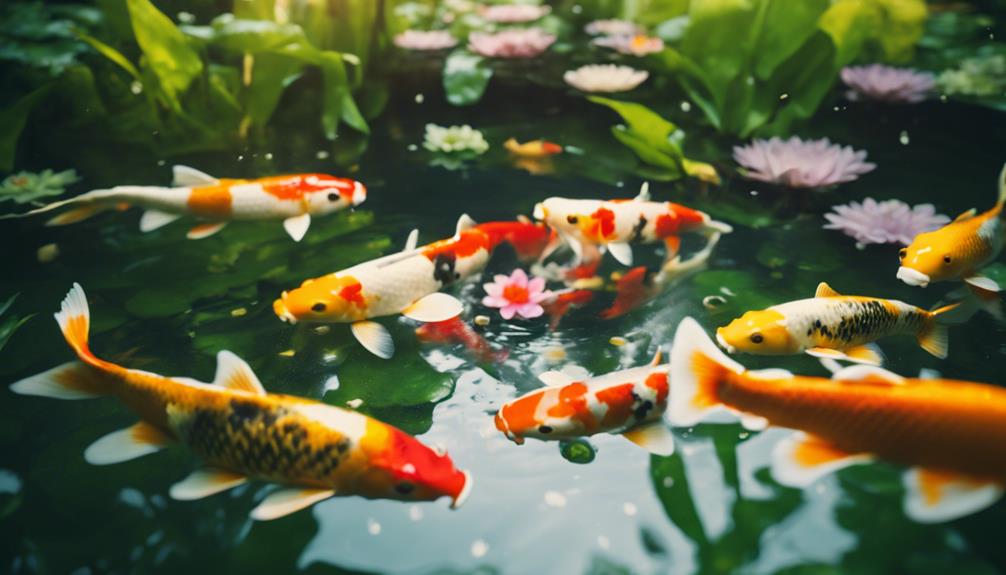You're about to set out on a journey to breed vibrant koi fish, with over 100 varieties to choose from! To set yourself up for success, start by understanding the different koi varieties and their characteristics. Next, set up a perfect pond with a round or oval shape, a minimum size of 1000 gallons, and a depth of at least 3 feet. Control water quality by maintaining a stable pH balance, testing parameters regularly, and performing water changes. As you prepare for spawning season, create a suitable environment, provide a balanced diet, and monitor for health issues. With these essential tips, you'll be well on your way to breeding vibrant koi fish – and there's still more to discover as you perfect your craft.
Table of Contents
Key Takeaways
- Provide a suitable spawning environment with a water temperature between 55°F to 65°F (13°C to 18°C) to stimulate koi reproduction.
- Maintain prime water quality by regularly testing and adjusting pH, ammonia, and nitrite levels to promote healthy egg development and fertilization.
- Offer a balanced diet rich in carotenoids to enhance coloration and provide essential nutrients for koi fry development.
- Create a safe and nourishing environment for koi fry by controlling water temperature, managing nutrition, and protecting from predators.
- Ensure a stable pH balance by implementing proper filtration, performing regular water changes, and adding pH-stabilizing products like crushed coral or limestone.
Understanding Koi Varieties
When venturing into the world of koi breeding, it is vital to familiarize yourself with the numerous varieties, as each type has its unique characteristics, scale patterns, and colors.
You'll soon discover that there are over 100 recognized koi varieties, each with its distinct features.
To breed the right koi fish, you need to understand the differences between them. For instance, some varieties, like the Kohaku, have bold red and white colors, while others, like the Sanke, display a more subtle pattern.
You'll also find koi with metallic scales, like the Kin-Gin-Rin, and those with elaborate patterns, like the Asagi.
To produce high-quality koi, it is paramount to choose the right parents. By selecting koi with desirable traits, you can breed fish with vibrant colors and patterns that will thrive in your pond.
With a solid understanding of koi varieties, you'll be well on your way to creating a stunning collection of these beautiful fish.
Setting Up the Perfect Pond
Now that you've got a solid grasp of koi varieties, it's time to create an ideal environment for your fish to thrive by designing and building a pond that meets their specific needs.
When it comes to pond design, a round or oval shape is best, as it mimics the koi's natural habitat and allows for efficient water circulation. Aim for a minimum size of 1000 gallons for a small group of koi fish, and guarantee the pond has a minimum depth of 3 feet to allow your fish to swim freely and prevent predators from accessing the pond.
Locate your koi pond in an area with at least 6 hours of sunlight and access to electricity, keeping it away from trees or other sources of debris that can be controlled.
Install a filtration system and aeration devices to maintain water quality and certify fish health. Regular inspections and cleaning will prevent potential issues.
Don't forget to add a protective net or wire mesh to deter birds and other predators, and include hiding spots like submerged pipes or tunnels, aquatic plants, or rock formations to provide shelter for your koi.
Breeding Koi in Spring
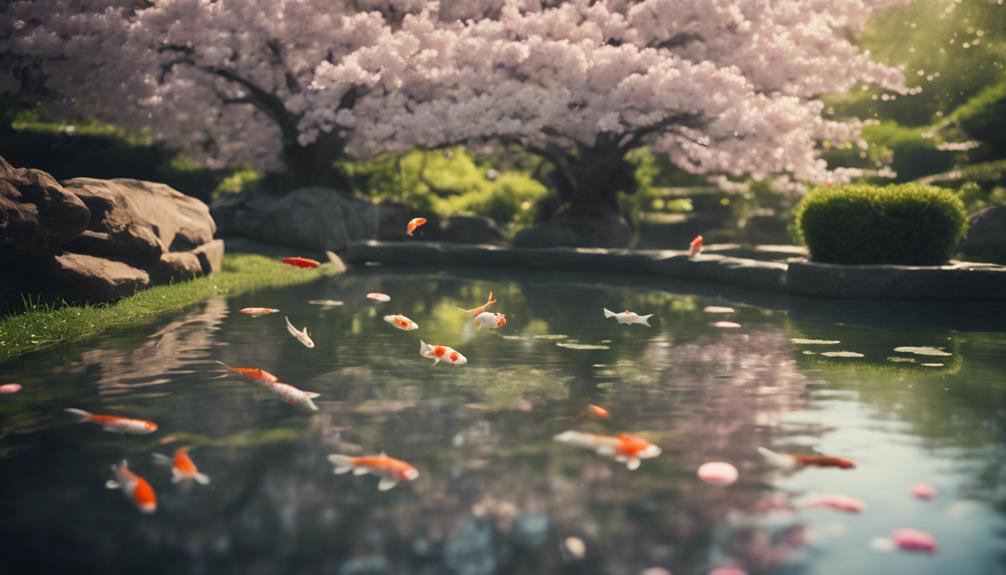
As you prepare to breed your koi fish, spring offers the perfect opportunity to capitalize on their natural instincts, with warmer temperatures stimulating their reproductive cycles.
During this season, your koi are more active and receptive to breeding, increasing the chances of successful spawning.
To optimize breeding koi in spring, guarantee the water temperature is between 55°F to 65°F (13°C to 18°C), as this range promotes healthy egg development and fertilization.
Keep a close eye on your pond in the morning, as koi typically spawn during this time.
Crucial to collect and fertilize the eggs promptly to increase the chances of successful koi breeding.
To facilitate egg-laying and fertilization, provide a spawning mat or plants with broad leaves, such as water lilies.
By following these guidelines, you'll be well on your way to successful koi breeding in the spring.
With the right conditions and attention, you'll be enjoying a thriving batch of vibrant koi fry in no time.
Caring for Koi Fry Essentials
As you care for your koi fry, you'll need to understand the essential components of their development.
You'll need to create a safe and nourishing environment, manage their nutrition, and monitor their growth stages to guarantee they thrive.
Fry Development Stages
You'll need to carefully monitor and support your koi fry through three critical development stages: egg, larvae, and juvenile, each with its unique demands and challenges.
During the egg stage, maintaining peak water quality is vital, as poor conditions can lead to egg mortality or deformities.
After hatching, provide a safe and predator-free environment for your fry to thrive.
Feeding: Offer infusoria or other small, nutrient-rich foods during the larvae stage, and gradually introduce commercial fry food as they grow and develop.
Water quality: Regular water changes and careful monitoring of water quality are essential during the juvenile stage, as koi fry are still vulnerable to disease and poor water conditions.
Predator protection: Guarantee a safe environment for your fry by providing a predator-free space, especially during the larvae stage when they're most susceptible to predation.
Fry Environment Management
To create an ideal environment for your koi fry, focus on providing a safe haven with essential elements such as suitable food, pristine water quality, and adequate shelter. This will promote healthy growth and development, and reduce stress and cannibalism.
| Environment Aspect | Optimal Conditions |
|---|---|
| Water Quality | Monitor and maintain zero ammonia and nitrite levels, with nitrate levels below 20 ppm |
| Food | Provide a balanced diet of brine shrimp or commercial fry food, gradually introducing larger foods as fry grow |
| Shelter | Guarantee adequate hiding places and plants to reduce stress and provide shelter |
Fry Nutrition Essentials
Providing your koi fry with a nutrient-rich diet is essential for their rapid growth and development, as they require a constant supply of protein and fat to thrive. You'll want to focus on feeding them foods that are high in protein and fat, such as live or frozen brine shrimp, infusoria, and commercial koi fry foods.
Feed frequently: Koi fry need to eat small amounts frequently, up to 5-6 times a day, to prevent overeating and reduce the risk of water pollution.
Monitor water quality: Regular water changes and monitoring of ammonia, nitrite, and nitrate levels are pivotal to prevent disease and stress in your koi fry.
Provide a varied diet: Introduce a variety of koi foods to guarantee your fry are getting a balanced diet, including protein-rich foods like brine shrimp and infusoria.
Ongoing Pond Management Tips
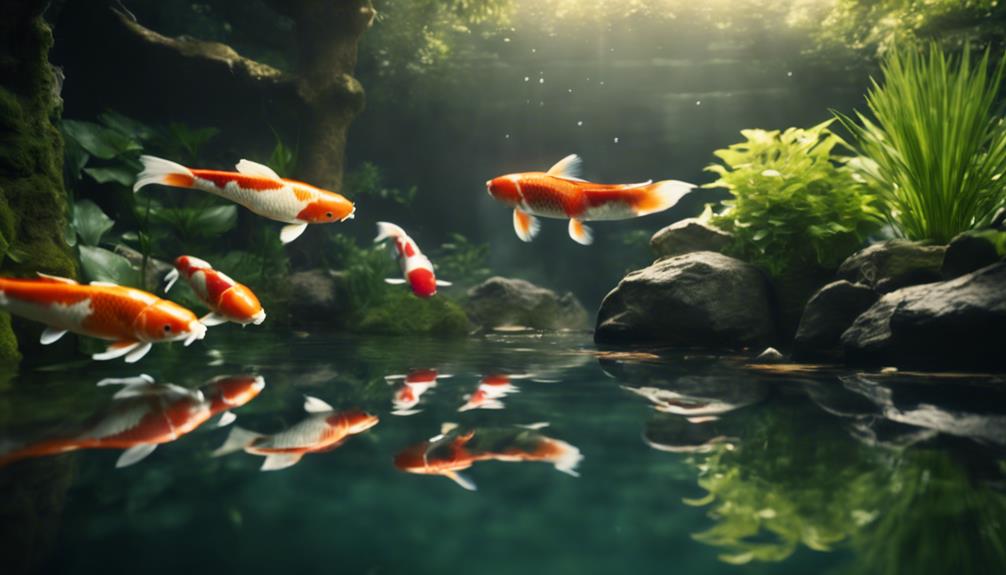
As you endeavor to create a thriving environment for your koi fish, ongoing pond management becomes essential to their health and well-being.
To guarantee proper water quality, you'll need to perform regular water changes – about 10-15% weekly – and treat new water with a de-chlorinator before adding it to the pond. This helps remove toxins and prevent water quality issues.
You'll also want to monitor the pond's ecosystem and make adjustments as needed, checking for signs of algae growth, excess debris, and predator activity.
Regularly inspect and clean your pond equipment, including filters and pumps, to prevent potential issues and achieve peak performance.
A consistent feeding schedule and balanced diet are also pivotal for your koi's overall health.
By following these ongoing pond management tips, you'll be able to provide a healthy and thriving environment for your koi fish to flourish.
Maintaining Optimal Water Quality
When breeding koi fish, you'll need to focus on maintaining superior water quality to guarantee the health and well-being of your fish.
To do this, you'll need to control water clarity, maintain a stable pH balance, and manage nutrient cycling effectively.
Water Clarity Control
You must prioritize water clarity control in your koi pond, since even slight deviations from ideal water quality can have devastating consequences for your fish. To maintain peak water clarity, you need to perform regular water testing to monitor parameters such as ammonia, nitrite, and nitrate levels.
Implement proper filtration: A balanced filtration system, including both biological and mechanical filters, is vital for removing waste products and maintaining water clarity.
Perform regular water changes: Replace 10-15% of the pond water weekly to remove toxins and maintain prime water quality. Remember to dechlorinate the new water before adding it to the pond.
Maintain proper aeration: Guarantee adequate oxygen levels in the water by providing proper aeration, which reduces stress in koi fish and prevents disease.
Ph Balance Maintenance
By maintaining a stable pH balance, you'll be able to create an environment where your koi fish can thrive, free from the stress and health issues that arise from fluctuating water acidity. A pH imbalance can be devastating to your fish, causing them to become lethargic, lose their appetite, and even develop diseases.
To maintain supreme water quality, you need to regularly test the pH levels of your water and make adjustments as needed. Aim for a pH range of 6.5 to 8.5, which is ideal for koi fish.
Regular water changes are vital in removing toxins and waste products that can affect the pH balance of your water. You should change at least 10-20% of your water weekly to maintain a healthy environment.
Additionally, make sure to add pH-stabilizing products to your water, such as crushed coral or limestone, to help maintain a stable pH balance. By following these tips, you'll be able to create a thriving environment for your koi fish, where they can grow strong and healthy.
Nutrient Cycling Management
Effective nutrient cycling management is crucial to maintaining ideal water quality, as it directly impacts the health and well-being of your koi fish.
To create a thriving environment, you need to maintain prime water quality by removing toxins and excess nutrients that can harm your koi.
Regular water changes and filtration: Perform 10-15% water changes weekly, along with proper filtration, to remove toxins and excess nutrients that can harm your koi.
Balance your ecosystem: Foster a symbiotic relationship between beneficial bacteria, which break down ammonia and nitrite, and plants, which absorb excess nutrients, to maintain prime water quality.
Monitor and adjust: Regularly test water parameters, including ammonia, nitrite, and nitrate levels, to identify and address any nutrient cycling issues that can impact koi health and water quality.
Providing a Balanced Koi Diet
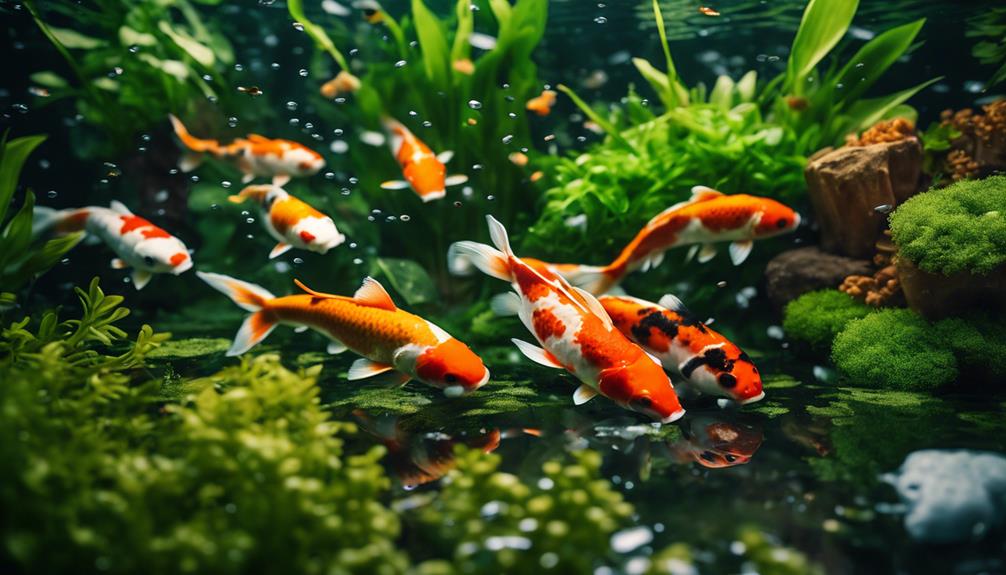
When it comes to feeding your koi, a balanced diet is crucial to maintaining their vibrant colors and overall health, and a high-quality commercial koi food should form the foundation of their nutrition.
This staple diet should be supplemented with natural foods like insects, earthworms, and aquatic plants to provide essential nutrients.
To create a beautiful koi habitat, feed your koi a varied diet that includes foods rich in carotenoids, such as spirulina algae and krill, to enhance their coloration and promote healthy skin and scales.
Avoid overfeeding by providing small amounts several times a day, rather than one large meal. This will reduce the risk of water pollution and maintain the efficiency of your types of filtration.
Adding fast-growing pond plants like Brahmi to the pond can provide a natural and nutritious food source for your koi, while also helping to maintain water quality.
Monitoring for Koi Health Issues
You must remain vigilant for signs of illness in your koi, as a healthy diet and environment are only half the battle in maintaining their overall well-being. Regular monitoring of your koi's health is vital to detecting potential issues early on. Keep an eye out for changes in behavior, appetite, or physical appearance, such as labored breathing, lethargy, or changes in color or finnage.
Some common health issues to watch for include:
- Fin rot: a bacterial infection that causes frayed or rotting fins.
- Ulcers: open sores on the fish's body that can be caused by bacterial or fungal infections.
- Parasites: anchor worms, fish lice, or flukes that can cause skin irritation, flashing, or erratic behavior.
If you suspect any of these issues, it's imperative to isolate the affected fish in a Quarantine Tank and seek professional advice. Early detection and treatment are critical to preventing the spread of disease and ensuring the long-term health and well-being of your koi.
Managing Koi Pond Ecosystem
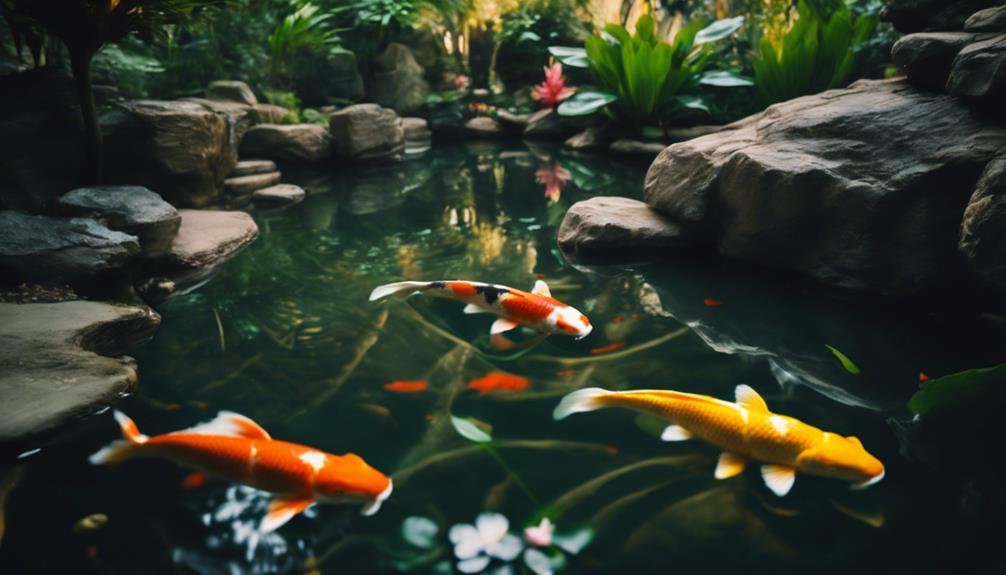
By carefully designing and maintaining a balanced ecosystem in your koi pond, you can create a thriving environment that supports the health and vibrancy of your fish.
When raising koi fish, a well-designed pond is vital, with a mix of shallow and deep areas, and a minimum depth of 3 feet to allow fish to swim freely and escape predators.
Incorporating aquatic plants, such as water lilies and hyacinths, can help maintain a balanced ecosystem by absorbing excess nutrients and providing shade for the fish.
To keep the water clean and healthy, regular water changes of 10-15% per week are essential, and a filtration system with both biological and mechanical components is necessary to remove waste products and excess nutrients.
Regular monitoring of water parameters, including pH, ammonia, nitrite, and nitrate levels, is critical for identifying and addressing any potential issues that could impact the health and well-being of the koi fish.
Preparing for Koi Spawning Season
As your koi fish mature, they'll require specific conditions to trigger spawning, and preparing your pond for this key reproductive phase is vital to guarantee successful breeding. You'll need to create an environment that mimics their natural habitat, encouraging your koi to reproduce.
To secure a successful koi spawning season, you'll need to:
- Maintain prime water quality: Regularly test and adjust pH, ammonia, and nitrite levels to create a healthy environment for your koi.
- Provide suitable spawning areas: Add plants or spawning mats to give your koi a comfortable surface to lay their eggs on.
- Control water temperature: Gradually raise the water temperature to around 65°F (18°C) to stimulate spawning.
Frequently Asked Questions
How Do I Make My Koi More Colorful?
To make your koi more colorful, you'll want to focus on the color gene, fin pattern, and scale shimmer. A diet rich in carotenoids, like spirulina, has a significant impact, enhancing color intensity and overall vibrancy.
How Do You Breed a Koi Successfully?
Did you know that 70% of koi breeding attempts fail due to poor water quality? You'll succeed by selecting healthy koi, preparing a suitable tank, and implementing a strategic breeding plan that guarantees prime water quality and a stress-free environment.
How to Encourage Koi Spawning?
To encourage koi spawning, you'll want to identify Spawning Triggers, maintain prime Water Quality, guarantee Tank Readiness, and isolate Mating Pairs, creating a conducive environment that stimulates natural breeding behaviors and increases the chances of successful spawning.
What Should You Do Firstly Before Attempting to Breed Koi?
Before attempting to breed koi, you should research water quality requirements, guarantee the health of your fish, study the genetics of your breeding stock, and prepare a suitable environment to increase your chances of success.
Conclusion
You've made it to the finish line!
With these 10 essential tips, you're now equipped to breed the most vibrant koi fish the world has ever seen!
Okay, maybe that's an exaggeration, but you get the idea – you're well on your way to creating a thriving koi paradise.
Remember, breeding koi is a journey, not a destination.
Stay vigilant, keep learning, and your pond will be teeming with healthy, stunning fish in no time.
Happy breeding!

